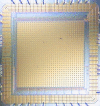Selective change driven imaging: a biomimetic visual sensing strategy
- PMID: 22346684
- PMCID: PMC3274326
- DOI: 10.3390/s111111000
Selective change driven imaging: a biomimetic visual sensing strategy
Abstract
Selective change driven (SCD) Vision is a biologically inspired strategy for acquiring, transmitting and processing images that significantly speeds up image sensing. SCD vision is based on a new CMOS image sensor which delivers, ordered by the absolute magnitude of its change, the pixels that have changed after the last time they were read out. Moreover, the traditional full frame processing hardware and programming methodology has to be changed, as a part of this biomimetic approach, to a new processing paradigm based on pixel processing in a data flow manner, instead of full frame image processing.
Keywords: CMOS image sensor; biomimetics; event-based vision; motion analysis.
Figures










References
-
- Stroble J.K., Stone R.B., Watkins S.E. An overview of biomimetic sensor technology. Sensor Rev. 2009;29:112–119.
-
- Schmitt O.H. Some Interesting Useful Biomimetic Transforms. Proceedings of the Third International Biophysics Congress; Boston, MA, USA. 29 August–3 September 1969; p. 297.
-
- Taghibakhsh F., Karim K.S. Two-transistor active pixel sensor readout circuits in amorphous silicon technology for high-resolution digital Imaging applications. IEEE Trans. Electron. Dev. 2008;55:2121–2128.
Publication types
MeSH terms
LinkOut - more resources
Full Text Sources

